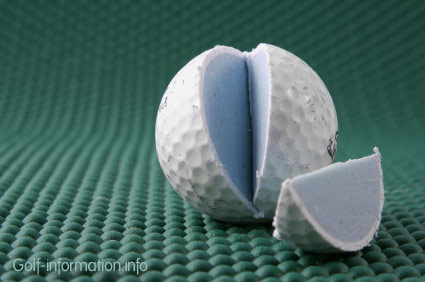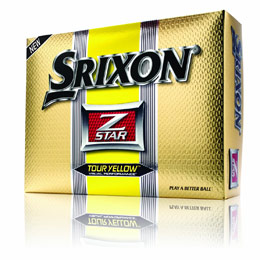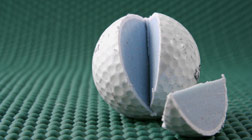Golf Ball Facts and Faqs

1. What material are golf balls made of ?
Golf balls usually consist of a solid rubber or resin core with a surlyn, polyurethane or balata cover. A surlyn cover gives a slightly harder feel, while a polyurethane cover gives a softer feel and greater control. The core can also consist of a liquid contained within a membrane. Additional layers can be added under the cover, such as a mantle layer and inner cover for increased performance and control.
2. Why do golf balls have dimples on their surface ?
Dimples are believed to add about 115% to the distance (as compared to nondimpled balls) by reducing the amount of drag on the ball and accentuating the effects of lift. They were first used in 1908.
Dimples on a regulation golf ball differ greatly from one golf ball to another, depending on their depth, alignment and distribution. Each dimple pattern has a different impact on the ball performances and manufacturers are constantly seeking to improve them. In order to include more dimple coverage, some patterns require the use of dimples of different sizes arranged in a structured, symmetric way on the same ball.
The number of dimples and nodes (dimple sizes) is not arbitrary. The optimum dimple number has been defined at about 350 to 450 per ball, but the number of dimples can vary from 252 to 500 dimples per ball. Some of the most popular number of dimples, according to Tibor Tarnai, an engineer at the Technical University of Budapest, are 332, 360, 384, 392, 416, 420, 432 and 480, all of which are found in commercial balls. There is also a tendensy to produce dimple patterns with the highest order of symmetry, leading from the Octahedron pattern, which divides the golf ball’s surface in eight identical triangles to the Icosahedron pattern, created by Titleist in 1973, dividing the ball’s surface into 20 identical triangles.
3. What do the terms multilayered golf balls, distance golf balls, low-spin golf balls and performance golf balls mean ?
Most golf balls come in a two-, three-, or four-layer design, known as a two-piece, three-piece, or four-piece ball respectively (the latter two being known also as multi-layered golf balls). Three-piece balls typically have a softer polyurethane or Surlyn cover and a mantle layer of rubber windings around a rubber core. Four-piece balls additionally have an inner cover made of a blend of ionomers and an outer cover made of Elastomer or Balata. One piece balls made of solid Surlyn are rarely used to play golf, but are used on practice grounds and driving ranges.
Manufacturers generally use four different denominations to characterize golf balls: distance golf balls, low-spin golf balls, soft feel golf balls and performance golf balls. Distance balls are usually two-piece balls with a large core designed for maximum velocity surrounded by a tin, cut-proof Surlyn cover. However, some companies are now making 3-piece distance balls that have a softer Surlyn cover and a harder Surlyn mantle layer. These new generation golf balls give the same distance, but with a softer feel, although they are not comparable to 3-piece performance balls. Performance balls exist in two-piece or three-piece versions.
To combine spin with distance a golf ball typically has to be multi-layered (three of four-piece balls), so low-spin golf balls typically are made of only two layers: a Surlyn cover and a core made of rubber combined with filler to obtain the proper weight. It is the Surlyn cover that makes a 2-piece ball feel hard and spin less, though more recent blends of the material give a softer feel and spin a little more. The cover of a 2-piece ball is usually also ticker which makes the golf ball more durable.
Thanks to the great variety in design and materials used, golfers of any level and different abilities can find a golf ball that suits their specific needs.
4. What type of golf ball (2-piece, 3-piece or 4-piece) should I choose for my game ?
Two-piece balls maximize distance and minimize spin. They are good for novice golfers and high handicappers with slow swing speeds or intermediate golfers just looking for more distance and less side spin. Also known as Distance balls or Low-spin balls.
Three-piece balls create low spin off a driver to provide distance, yet provide more spin off iron shots. Ideal for intermediate golfers golfers looking for a softer feel, who have no problem with distance and can make an efficient use of backspin.
Three-piece performance balls sacrifice a little distance off the tee but offer more control around the green. Good for more experienced players. (see column right)
Two-piece performance balls have enlarged cores (as compared to traditional two-piece balls) made of different layers of a mix of materials going from stiffer at the center to more elastic in the outer layers of the cor. These balls offer great length off the tee together with nearly the same characteristics of control of 3-piece performance balls. (see column right)
Four-piece balls are generally recommended for expert players with faster swings, who never slice or hook and have a perfect control of backspin. Four-piece balls produce high spin off wedges and short irons for maximum stopping power, while offering a soft feel and exceptional control around the green. (see column right)
Whichever type you choose, stick to your choice for a while to get used to the new golf balls and develop some consistency in your play.
5. What is meant by compression rate of a golf ball ?
Traditionally 3-piece balls have a spherical solid rubber or fluid-filled center around which many yards of a stretched elastic thread are wound forming a wound core. The tightness of these thread windings determined the golf ball’s compression rate. Due to recent technological advancement, however, the compression rate is now merely an expression of feel and of how much the golf ball is deflected when hit, or how the contact between clubhead and ball is prolonged, as a consequence.
The compression rating of golf balls usually ranges from 70-110, but the complete scale goes from 0 to 200, with 0 standing for a ball which can be deformed by 0.2 inches or more, and 200 standing for a ball that does not deform at all. The lower the compression, the softer the feel. Contrary to popular belief high compression balls do not necessarily fly farther, as other components such as clubhead speed, swing speed, the club’s loft angle and dimple pattern are as important in determining distance.
Low compression balls
Low compression golf balls typically have a compression rate of 70-80 and are easily compressed (i.e. deformed) when they are hit by the clubhead. They are usually used by novice players and players with a slower swing or slower club head, although some tour players prefer these golf balls because of the soft feel.
Medium compression balls
Most advanced golfers will prefer playing with a golf balls having a medium compression rate of 90. These medium compression balls provide both softness and ease of control.
High compression balls
Players with high club head speeds usually choose high compression golf balls with 100-110 compression rating, which are less likely to deform upon impact.
6. Are there any regulations regarding the size and weight of a golf ball ?
Yes, an appendix to the “Rules of Golf” defines that a golf ball must not weigh less than 45.93 grams (1.620 oz), that its diameter must not be less than 42.67 mm (1.580 in), and that its shape may not differ significantly from a symmetric sphere. Like golf clubs, golf balls are subject to testing and approval by the Royal and Ancient Golf Club of St Andrews and the United States Golf Association, and those that do not conform with the regulations may not be used in competitions (Rule 5-1).
Recommended Golf Balls:

324 Advanced dimple pattern, all ability ball, offering distance of the tee and spin control around the green.
More info>>
Best golf ball on the market for intermediate players (15+ handicappers), offering perfect combination of distance off the tee with less slice/hook. For lower handicappers, see the Z-star below.

325 Aerodynamic Dimple Design produces a penetrating ball flight
More info>>
One of the only optic yellow golf balls at premium level (equivalent of the Titleist Pro V1, which only exists in white, though). This ultimate multi-layered golf ball offers superb feel and distance control thanks to its super soft, ultra thin Urethane cover.
See also:
All-time favorite golf balls
More golf balls

